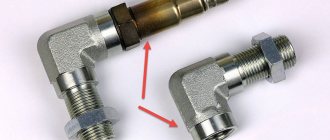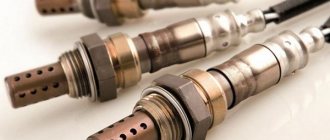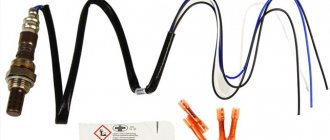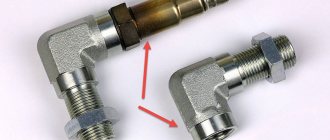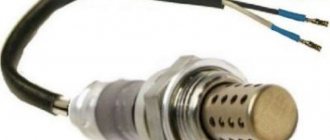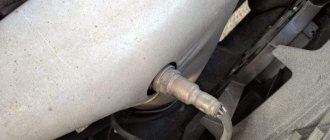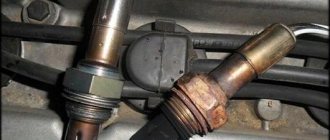In this article I want to talk about how you can make a lambda probe or oxygen sensor with your own hands. Usually such decoys are made when cutting out the catalyst, its poor performance, or when the second lambda probe is faulty, then you can install a decoy without buying a new one.
A lambda probe or oxygen sensor converts data on how much oxygen is contained in the exhaust gases into an electrical signal. The sensor sends an electrical signal at the moment when it detects changes in oxygen, the signal is transmitted to the controller, which receives the signal and compares the received data with the indicators stored in memory.
If the received data does not coincide with the optimal values for the current mode, the control unit changes the fuel injection duration accordingly. This is done to achieve maximum engine efficiency, save fuel and reduce the amount of harmful emissions into the atmosphere.
Usually, recently, two sensors are installed on cars, one before the catalyst, the second after the catalyst, the signals from these two sensors should be different, then the control unit regulates the injection duration according to the received signals from 2 sensors, but if one of the sensors fails or the car owner removed the catalyst, or alternatively replaced it with a flame arrester, the signals from the 2 sensors will begin to coincide, which will be perceived by the control unit as an emergency mode.
In this case, the controller will select average injection control parameters, which will ultimately lead to an increase in fuel consumption with a simultaneous decrease in engine power and its unstable idling, and “Check-Engine” will light up on the dashboard, indicating an error.
So, let's consider the mechanical type of blende, this is when a spacer is installed in place of the second sensor, and then a lambda probe is screwed into it.
The spacer can be made according to the drawing below, which has been tested for more than one year of operation.
But I think it’s more effective to make a blende using the second method, since I don’t know a turner, but I can probably solder one resistance and a capacitor. The figure below shows how to install a capacitor and resistor into the wires that go to the oxygen sensor.
This method is also time-tested and has proven itself on the positive side.
And I also want to note one point that sometimes the heater of the sensor itself fails, in this case the “Check-Engine” error also appears, but even here you can put a trick.
This can be done this way, without unscrewing the oxygen sensor, we connect to two white wires that go to the sensor heater, a simple car light bulb, for example, from the dimensions, it is desirable that it has a resistance of 4 to 12 Ohms (the resistance varies on different cars).
The resistance of the light bulb will tell the ECU that the heater is in good condition and will not generate an error. This is only acceptable for the second oxygen sensor, which is located after the catalyst.
And to summarize, making a fake oxygen sensor is not such a difficult task. Good luck to everyone on the roads.
In cases where the neutralizer is removed or replaced with a flame arrester , the ECU begins to malfunction, causing emergency operation. At such moments, experienced motorists use a corrector for the operation of the oxygen lambda probe, which allows them to avoid mistakes and continue operating the car.
Do you need an oxygen sensor emulator?
- The ECU puts the engine into emergency mode when the engine operates according to the specified fuel maps without taking into account the readings of the oxygen sensors.
- The “Check Engine” indicator lights up on the dashboard and an enriched fuel mixture enters the cylinders.
- Soot on the spark plugs increases, the power of the internal combustion engine decreases and the oil becomes contaminated.
- Increased fuel consumption entails extra financial costs.
Almost all automakers recommend replacing a faulty converter. But not every car owner will do this, because the price of some copies, for example, for VAZ, reaches 60,000 rubles. It is also worth adding the cost of installing the device. Therefore, many car enthusiasts are interested in what a do-it-yourself catalyst blende is and the scheme for its implementation.
The essence of the emulator's operation is to change the real sensor readings, after which the ECU switches to normal operation. In this case, the neutralizer itself can be cut out or replaced with a flame arrester. The procedure for installing a simulator is no more complicated than increasing the ground clearance of a Renault Duster.
Possible consequences
This method of fooling a car computer is a risky endeavor. The following may happen:
- Failure of all sensors without the right to restoration.
- Many different errors can appear in the on-board computer.
- Wiring problems.
- The engine may malfunction because when the computer should give a signal - to supply a rich mixture or, conversely, a lean mixture, but it will not do this, because the snag shows that everything is normal.
How to make a mechanical corrector for the exhaust system?
To implement a mechanical blende for the catalyst with your own hands, it is recommended to use blanks made of heat-resistant steel or bronze. This way the parts will not be deformed due to high temperature. There are two designs, but both options require a lathe or the help of an experienced turner.
First option
It is a sleeve 40-100 mm long. On one side, a standard sensor is screwed in, and on the other, the circulation of gases is limited by a small diameter hole. The essence of the “device” is that the composition of the exhaust mixture is averaged, because the lambda probe is removed from the gas stream itself and, accordingly, catches fewer toxic substances. Due to this, it is possible to deceive the ECU.
A typical drawing with spacer dimensions can be changed in terms of dimensions, it depends on the model and brand of the car. The optimal inlet diameter remains unchanged - 1.5-2 mm. In some cases, the length of the bushing may not allow it to be installed in its original place. As a result, you have to weld the mount elsewhere in the exhaust pipe.
Second option
- Exhaust gases enter the bushing body through a small diameter hole.
- In the volume of the spacer, excess CH and CO are subject to oxidation by oxygen, as a result of which the concentration of harmful substances decreases.
- The ongoing processes change the shape of the sinusoid, and the electronic system believes that the catalytic converter is operating normally.
A do-it-yourself catalyst blende made according to the above diagram has advantages similar to the previous option. Here the standard probe will be raised by 32 mm, although this is less than 40-100 mm.
Features of spacer installation
The installation procedure is not difficult, and begins with placing the car on an overpass or lift. Further actions occur according to the following scheme:
- Disconnect the negative terminal of the battery.
- Unscrew the controller.
- Screw the bushing onto the probe.
- Screw the upgraded unit into place.
- Connect the battery.
After the first start, the Check Engine light should go off. The motor will now operate normally.
Why do you need to fool the oxygen sensor?
If you found out the cost of replacing oil seals and decided to delay this procedure, then remember - the catalytic converter does not last forever. It’s rare that anyone replaces it with an analogue, much less an original. It is much cheaper to install a flame arrester, and solve the issue of additional oxidation of harmful substances in exhaust gases by installing a catalyst blende yourself. The idea of this solution is not to remove the second oxygen sensor, but to make it show the readings necessary for the normal functioning of the ECU.
If you cut out the catalyst and leave everything as it is in the electronic engine management system, you will instantly get a lambda error. This will be indicated by the Check Engine icon, a “stifled” gas pedal and increased fuel consumption.
For your information. A lambda probe, located immediately behind the exhaust manifold, is found on all injection engines. The second sensor appeared on cars with EURO 3 class and higher.
There is only one alternative to emulation - flashing. Control programs under EURO 2 see only one oxygen sensor - the one that corrects mixture formation. “Sewing” the ECU just to disable the second sensor is expensive, and the reliability of non-original firmware can be poor.
What is a lambda probe emulator
To deceive the oxygen sensor means to force it to produce standard values. That is, show the electronic engine control system that there is a catalytic converter and it properly cleans exhaust gases.
What does it look like
There are two types of decoys: mechanical and electronic. A table with a photo gives a general idea of what they are like.
| Type of blende | Subspecies | Photo of the emulator |
| Mechanical | Plug with hole | |
| Bushing with minicatalyst | ||
| Electronic | Autonomous unit with microcontroller | |
| Resistor and capacitor circuit |
Where is it placed?
- Any of the mechanical decoys is a bushing that is screwed in instead of the original lambda, and the sensor is already placed directly into this screw.
- The resistor and capacitor are soldered into the contact gap of the original sensor.
- An autonomous unit with a microcontroller is placed between the block and the lambda probe.
Do-it-yourself mechanical blende of an exhaust system catalyst
The table presented two types of “mechanics”. The scope of their application is different, the design and principle of operation are different.
Attention! When choosing/making a mechanical lambda probe with your own hands, evaluate the amount of space above the second oxygen sensor. If there is a deficiency, it is necessary to use a rotary sleeve.
Option No. 1: screwdriver with a small diameter hole
So-called “empty” mechanical emulators are suitable for a narrow series of cars with EURO 3. Tentatively, these are foreign cars produced before 2004 and domestic cars produced before 2011.
Principle of operation
The function of the bushing is to isolate the lambda from the direct flow of gases, which contains a lot of oxygen. Through the small hole, only a small part of it reaches the sensor, but enough for the sensor to respond to the ECU with a qualified signal.
How to do
Where is it placed?
Option No. 2: bushing with minicatalyst
Suitable for cars of any EURO environmental class.
How does it work
Manufacturing technology
It is difficult to make on your own due to the inaccessibility of small-sized copies of catalysts. Otherwise, the technology is not much different from that specified in option No. 1. The work is carried out on a lathe; the dimensions are entered in the drawing after preliminary measurement of the sensor thread and the seat for it.
How to install
The installation technology is identical to the method described in option No. 1: unscrew the oxygen sensor and screw it into the adapter sleeve. Screw the assembly unit into the exhaust pipe.
Important! When using bushing spacers of any type, the lambda must be in good working order.
Do-it-yourself electronic snag of the second lambda probe: diagram and recommendations
The table shows two types of electronic designs. If we evaluate it strictly, then only a circuit made of a resistor and a capacitor falls under the definition of a handmade blende, since it can be made by yourself. The autonomous unit operates on the basis of a microcircuit, which is difficult to solder at home.
Option #1: Integrating a resistor and capacitor into the wiring
A universal circuit suitable for many machines is shown in the photo. When designing with your own hands, you should only take into account the configuration of the electronic blende of the second lambda probe:
- The resistor is soldered into the break in the signal wire.
- A non-polar capacitor is connected to the ground gap and the signal contact.
The characteristics of the components are selected individually for each vehicle. Let’s say for Mitsubishi Lancer X you need a pulse resistor of 1 MOhm, 0.5 W, 5% and a non-polar “condenser” of 2.2 μF, 50 V. And for Nissan Primera - a resistance of 150 kOhm, 1 W + a capacitor of the same class, only at 1 µF.
There are plenty of examples of unsuccessful lambda deception. Let's say on the Audi A4 this kind of intervention is pointless. After soldering the components, the system records the fact that incorrect readings are being given or there is no signal at all from the sensor.
For your information. Thematic forums for specific cars or blogs of users of the automotive social network DRIVE2.RU will help you find out the characteristics of the resistor and capacitor that are suitable for your car, and generally make sure that this method will give results.
Option No. 2: microprocessor board in the lambda probe wiring break
Intelligent emulators based on medium-complexity chips are often purchased ready-made. The device has a presentable appearance: the connection is made without any twisting/soldering - only connector blocks.
For your information. When purchasing, it is important to discuss with the seller the compatibility of the electronic catalytic converter with the firmware version of the central computer of your car.
Which lambda probe decoy is better to install?
The advantage of mechanics is that there is no electrical part, which means there is nothing to break. But it is useless if the oxygen sensor is broken. If you do not take into account homemade electrical circuits based on a resistor and capacitor, then a full-fledged electronic blende can be considered as an alternative to purchasing a new oxygen sensor.
| Emulator selection table depending on the year of manufacture of the car and the sales market | ||
| Sale market | Mechanical snag | Electronic snag |
| European Union | 1997-2000 | 2001-present |
| USA | 1996-1999 | 2000-present |
| Japan | 1998-2003 | 2004-present |
| Russia | 2004-2005 | 2006-present |
| Belarus | 2006-present | 2007-present |
| Ukraine | 2007 | 2008-present |
After all, many microprocessor emulators do not need a lambda probe. They generate a signal using information from the first lambda. The main thing is to choose the right device so that it matches the specific ECU.
In total, we advise you to follow two recommendations:
- A device with a minicatalyst is the best option.
- Microprocessor unit - if it was not possible to unscrew the lambda probe or it has failed.
Asking price in the store and at the service station
The trick is positioned as a cheap alternative to flashing it for EURO 2. Indeed, they ask for at least 15,000 rubles to change the ECU software. Even the most expensive standalone emulator with installation costs a maximum of 8-10 thousand rubles.
At the same time, the factory engine control program is preserved, and hence the reliability of the system as a whole.
If you take the best option, a fake with a minicatalyst, then the problem with the ECU can be completely solved for 1,000-2,000 rubles.
And for owners of cars with low-sensitive sensors (EURO 3) it will cost even less: 500-1,000 rubles.
Do-it-yourself electronic catalyst blende and emulator circuit
A real electronic emulator is a microprocessor device consisting of a single-chip microcircuit. The principle of its operation is based on the formation of an output signal, which in shape corresponds to the information in the working neutralizer. This option is difficult to do on your own, so you should immediately consider a simpler method. To implement it you need to prepare:
- Electric soldering iron.
- Solder and rosin.
- Knife and side cutters.
- Resistance 200 Kom, power 0.25 W.
- The capacitor is non-polar with a capacity of 4.7 microfarads.
Asking price in the store and at the service station
The trick is positioned as a cheap alternative to flashing it for EURO 2. Indeed, they ask for at least 15,000 rubles to change the ECU software. Even the most expensive standalone emulator with installation costs a maximum of 8-10 thousand rubles. At the same time, the factory engine control program is preserved, and hence the reliability of the system as a whole.
If you take the best option, a fake with a minicatalyst, then the problem with the ECU can be completely solved for 1,000-2,000 rubles. And for owners of cars with low-sensitive sensors (EURO 3) it will cost even less: 500-1,000 rubles.
What do spare parts manufacturers offer?
On the shelves of auto stores you can find all kinds of parts for tuning the exhaust system. The production of mechanical simulators of the normal operation of the catalytic converter is made of bronze or chrome-plated steel. The price of such devices ranges from 400 to 800 rubles, and a standard installation at a service station will cost about 500 rubles.
A spacer with a minicatalyst is offered much more expensive than its elementary counterpart, its cost is 1,500-4,000 rubles. Simple electronic emulators of industrial production are sold for 1,500-3,000 rubles. The range of prices for flashing ECU software is quite wide - from 1,000 to 30,000 rubles.
Modern cars are equipped with various control systems, including lambda probes. The latter also have names: oxygen controller, O2 sensor and DC. This controller is part of an exhaust system that meets EURO-4 and higher emission standards. If the probe malfunctions, the motor goes into emergency mode and an error signal is displayed on the panel. To outwit the system, car owners came up with the idea of using a lambda probe decoy; every car owner with knowledge in electronics can make it with their own hands. Today we will take a closer look at how you can do this.
Alternative options
If you do not take into account the possibility of repairing the catalyst or oxygen sensor, then problems in the operation of the lambda probe can be eliminated by reprogramming the electronic control unit (ECU).
This method is used, as a rule, only on cars of the Euro-2 environmental class. The main disadvantage of flashing is the fact that it is practically impossible to perform such an operation yourself, and the work of a specialist will be quite expensive. The qualifications of the service station employee who carries out the work of changing the ECU settings are very important, because if serious errors are made, the system firmware may crash during operation of the machine.
Such manipulation of settings is economically justified only in the case when, in addition to disabling the lambda probe, the system is reflashed in order to increase engine power.
What is a lambda probe and why is it needed?
The emergence of such mechanisms was provoked by strict environmental standards. After the installation of catalytic converters in modern cars, it became necessary to control the composition of the air-fuel mixture. This function was taken over by the lambda probe.
The name is based on the Greek letter representing excess air in the air-fuel mixture. Lambda probe is a sensor for measuring the qualitative composition of exhaust gases. If the lambda probe is faulty, the ECU begins to operate according to average parameters. This leads to increased fuel consumption, decreased power and other unpleasant consequences.
The lambda probe is the most vulnerable sensor in a car, so car owners have come up with the idea of using special tricks that allow them to transmit the necessary indicators to the sensor or block them altogether.
Note: why does the catalyst fail prematurely?
Low quality gasoline and careless dosing of cleaning additives can impair the permeability of the catalytic converter honeycombs. This is the main reason for the reduction in its service life. Therefore, ask which gas station is better to refuel at
in your region, and how to properly use
additives to improve the quality of gasoline
.
The catalyst also painfully endures strong vibrations, such as driving on a bad road at high speed, and sudden temperature changes. If you throw snow onto a hot surface, critical deformations are inevitable.
Consequences of installing different types of decoys
When installing decoys, you should take into account that all work is performed at your own peril and risk. If such devices are installed incorrectly, the following malfunctions may occur:
- Engine malfunction due to incorrect injection adjustment by the on-board computer.
- Damage to the wiring and controller due to improperly soldered circuitry.
- Errors when operating the on-board computer.
- Damage to sensors.
Work with any electronics must be done extremely carefully. Even the slightest inaccuracy can lead to damage, so you need to strictly follow the instructions.
Advice: Do not order fakes on the Internet from dubious sites. Most of them work poorly and will not bring the expected results.
Many car enthusiasts practice decoys of lambda probes. Such devices allow you to save on replacing failed sensors. It is important to make the blende correctly and install it so that there are no negative consequences for the on-board computer or engine.
Publication date: January 16, 2022. Category: Automotive equipment.
Lambda probe (also called oxygen controller, O2 sensor, DC) is an integral part of the exhaust system of vehicles that meet EURO-4 environmental standards and higher. This miniature device (usually 2 or more lambda probes are installed) monitors the O2 content in vehicle exhaust mixtures, thereby significantly reducing the emission of toxic waste into the atmosphere.
If the DC is not operating correctly or if the lambda probe is disconnected, the functioning of the power unit may be disrupted, causing the engine to go into emergency mode (the Check Engine light will light up on the panel). To prevent this from happening, the car system can be outsmarted by installing a decoy.
How to ensure the emulator works correctly?
In order for the second lambda probe to function correctly, three basic conditions must be met:
- choose the right blende based on the design features of the car;
- follow the technology for installing a spacer on the second lambda probe;
- carry out system performance testing after the completed set of works.
When installing the emulator, our car service strictly adheres to these rules, which ensures high results and long-term operation of the system in normal mode.
Which lambda decoy is better?
Unambiguously answer the question “Which lambda decoy is better?” impossible. Each device has its own pros and cons, and different compatibility with certain models. Which lambda probe decoy is best installed depends on the purpose of this manipulation and specific conditions:
- mechanical blende operate only in conjunction with a working oxygen sensor;
- To simulate the normal operation of an oxygen sensor on an old gas equipment, only electronic fakes with a microcontroller (pulse generator) are suitable;
- on old cars of a class no higher than Euro-3, it is better to install a screw-in screw - cheap and reliable;
- on more modern cars (Euro-4 and higher) it is better to use mini-catalysts;
- the option with a resistor and capacitor is a cheaper, but less reliable type of blende for new cars;
- An emulator of a second lambda probe on a microcontroller, powered by the first one, is the best option for a car with a failed or removed second oxygen sensor.
Generally speaking, a mini-catalyst is the best option for a working DC, because it highly reliably imitates the operation of a standard converter. A microcontroller is a more complex and expensive option, and therefore is only appropriate when there is no standard sensor at all or it needs to be tricked to drive on gas.
Source
Why do you need flashing?
The most experienced motorists reflash the ECU to block processing of signals from the 2nd sensor. This is a risky decision, since any adjustment to the electronic system often irreversibly changes the settings. It will be almost impossible to go back to factory settings.
You shouldn't do the flashing yourself. It's better to leave it to the experts. They will cancel the transmission of signals from sensors using special equipment. But even then there is no guarantee that after changes in the operation of the control system there will be no problems.
